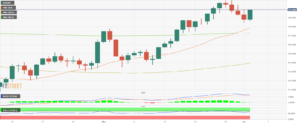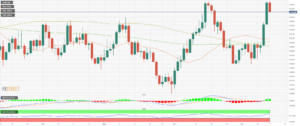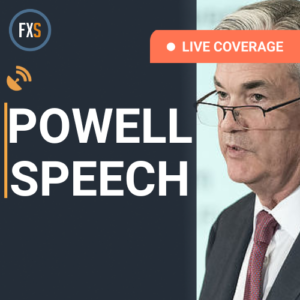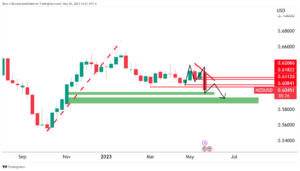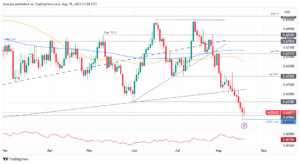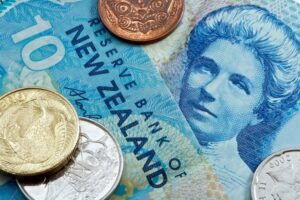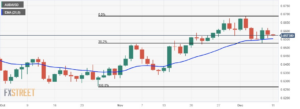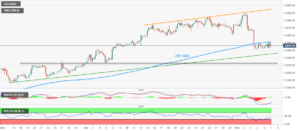
- Gold price hovers around $1,900.00 as investors await Fed minutes.
- The US Dollar capitalizes on US economic resilience and a slowdown in China.
- Robust consumer spending momentum driven by strong wage growth may keep US core inflation sticky.
Gold price (XAU/USD) flirts with the crucial support of $1,900 as investors await the Federal Open Market Committee (FOMC) minutes to attain guidance about inflation and the interest-rate peak. The precious metal continues to find offers from market participants as the US Dollar and Treasury yields strengthen due to the resilience of the US economy, which contrasts with China’s poor economic outlook.
Robust consumer spending momentum fueled by strong wage growth indicates resilience in the US economy, which could keep core inflation sticky and would force Federal Reserve (Fed) policymakers to keep interest rates high for a longer period. Fed policymakers are expected to keep the interest-rate policy unchanged in September as spending on big-ticket items softens due to higher rental costs.
Daily Digest Market Movers: Gold price awaits FOMC minutes
- Gold price aims for sustainability above $1,900, aided by a directionless US Dollar ahead of the FOMC minutes, which will be released at 18:00 GMT.
- FOMC minutes of the September monetary policy meeting will provide interest rate guidance and the inflation outlook for the remainder of 2023.
- According to the CME Group FedWatch Tool, markets broadly expect interest rates to remain unchanged for the rest of the year.
- However, US economic resilience due to stronger consumer spending momentum and tight labor market conditions could force Federal Reserve policymakers to keep interest rates high for a longer period.
- On the contrary, Minneapolis Fed President Neel Kashkari said on Tuesday that while the US central bank has made some progress in its inflation fight, interest rates may still need to go higher to finish the job.
- The US Dollar Index manages to keep auction around 103.00 amid further evidence of an economic slowdown in China and US strong consumer spending momentum.
- The Chinese economy is facing a turbulent environment amid a slowdown in overall demand and declining exports.
- The People’s Bank of China (PBoC) cut the one-year medium-term lending facility (MLF) rate by 15 basis points (bps) to 2.50% in order to keep liquidity in the banking system at reasonably ample levels.
- A dovish interest-rate decision from the PBoC came after new home prices in China fell in June for the first time this year.
- An economic slowdown of the Chinese economy has improved the appeal for the US Dollar.
- US retail sales, a proxy for consumer spending, expanded at a higher pace in July partly driven by strong wage growth. Retail Sales rose by 0.7%, more than the 0.4% expected and the 0.2% increase seen a month earlier. Retail Sales excluding automobiles rose by 1.0%, indicating robust demand for both durables and quick consumables.
- 10-year US Treasury yields remain around 4.20% as investors hope interest rates will remain high for longer amid an upbeat economic outlook.
- The risk profile remained bearish as Fitch warned about the downgrading of some of the big US lenders. After the downgrade of the US banking industry’s “operating environment” to AA- from AA, the credit rating firm warned of downgrading multiple banks including J.P. Morgan.
- Apart from the FOMC minutes, investors will also focus on monthly Industrial Production data for July. Production is seen expanding by 0.3%, swinging from a 0.5% contraction in June.
Technical Analysis: Gold price hovers below 200-EMA
Gold price struggles to maintain auction above the immediate support of $1,900. The precious metal continues to face selling pressure due to strength in the US Dollar and Treasury yields. The yellow metal continues its downside journey after a bearish crossover from the 20- and 50-day Exponential Moving Averages (EMAs). Gold price hovers around the 200-EMA and a confident breakdown below this level will expose it to more downside.
Fed FAQs
Monetary policy in the US is shaped by the Federal Reserve (Fed). The Fed has two mandates: to achieve price stability and foster full employment. Its primary tool to achieve these goals is by adjusting interest rates.
When prices are rising too quickly and inflation is above the Fed’s 2% target, it raises interest rates, increasing borrowing costs throughout the economy. This results in a stronger US Dollar (USD) as it makes the US a more attractive place for international investors to park their money.
When inflation falls below 2% or the Unemployment Rate is too high, the Fed may lower interest rates to encourage borrowing, which weighs on the Greenback.
The Federal Reserve (Fed) holds eight policy meetings a year, where the Federal Open Market Committee (FOMC) assesses economic conditions and makes monetary policy decisions.
The FOMC is attended by twelve Fed officials – the seven members of the Board of Governors, the president of the Federal Reserve Bank of New York, and four of the remaining eleven regional Reserve Bank presidents, who serve one-year terms on a rotating basis.
In extreme situations, the Federal Reserve may resort to a policy named Quantitative Easing (QE). QE is the process by which the Fed substantially increases the flow of credit in a stuck financial system.
It is a non-standard policy measure used during crises or when inflation is extremely low. It was the Fed’s weapon of choice during the Great Financial Crisis in 2008. It involves the Fed printing more Dollars and using them to buy high grade bonds from financial institutions. QE usually weakens the US Dollar.
Quantitative tightening (QT) is the reverse process of QE, whereby the Federal Reserve stops buying bonds from financial institutions and does not reinvest the principal from the bonds it holds maturing, to purchase new bonds. It is usually positive for the value of the US Dollar.
- SEO Powered Content & PR Distribution. Get Amplified Today.
- PlatoData.Network Vertical Generative Ai. Empower Yourself. Access Here.
- PlatoAiStream. Web3 Intelligence. Knowledge Amplified. Access Here.
- PlatoESG. Automotive / EVs, Carbon, CleanTech, Energy, Environment, Solar, Waste Management. Access Here.
- PlatoHealth. Biotech and Clinical Trials Intelligence. Access Here.
- ChartPrime. Elevate your Trading Game with ChartPrime. Access Here.
- BlockOffsets. Modernizing Environmental Offset Ownership. Access Here.
- Source: https://www.fxstreet.com/news/gold-price-looks-vulnerable-as-fomc-minutes-loom-202308160937
- :has
- :is
- :not
- :where
- ][p
- 1
- 15%
- 2%
- 2008
- 2023
- 31
- 40
- a
- About
- above
- Achieve
- After
- ahead
- aims
- also
- Amid
- an
- analysis
- and
- Animate
- appeal
- ARE
- around
- AS
- At
- attain
- attractive
- Auction
- automobiles
- await
- Bank
- Bank of China
- Banking
- banking industry
- banking system
- Banks
- basis
- BE
- bearish
- below
- Big
- board
- Bonds
- Borrowing
- both
- Breakdown
- broadly
- buy
- Buying
- by
- came
- central
- Central Bank
- China
- Chinas
- chinese
- choice
- CME
- CME Group
- committee
- conditions
- confident
- consumer
- content
- continues
- contraction
- contrary
- contrasts
- Core
- core inflation
- Costs
- could
- credit
- credit rating
- crises
- crisis
- crucial
- Cut
- data
- decision
- decisions
- Declining
- Demand
- Digest
- does
- Dollar
- dollar index
- dollars
- Dovish
- Downgrade
- downside
- driven
- due
- during
- Earlier
- easing
- Economic
- Economic Conditions
- economy
- eleven
- employment
- encourage
- ends
- Environment
- evidence
- excluding
- expanded
- expanding
- expect
- expected
- exponential
- exports
- extreme
- extremely
- Face
- Facility
- facing
- Falls
- FAQ
- Fed
- Fed Minutes
- Federal
- Federal Open Market Committee
- federal reserve
- Federal Reserve Bank
- Federal Reserve Bank of New York
- fight
- financial
- financial crisis
- Financial institutions
- financial system
- Find
- finish
- Firm
- First
- first time
- fitch
- flow
- Focus
- FOMC
- fomc minutes
- For
- Force
- Foster
- four
- from
- fueled
- full
- further
- GMT
- Go
- Goals
- Gold
- gold price
- grade
- great
- Greenback
- Group
- Growth
- guidance
- High
- higher
- holds
- Home
- hope
- HTTPS
- immediate
- improved
- in
- Including
- Increase
- Increases
- increasing
- index
- indicates
- indicating
- industrial
- Industrial Production
- industry
- inflation
- institutions
- interest
- INTEREST RATE
- Interest Rates
- International
- international investors
- Investors
- IT
- items
- ITS
- J.P. Morgan
- Job
- journey
- jpg
- July
- june
- Keep
- labor
- labor market
- lenders
- lending
- Level
- levels
- Liquidity
- longer
- Low
- lower
- made
- maintain
- MAKES
- manages
- mandates
- Market
- market conditions
- Markets
- May..
- measure
- meeting
- meetings
- Members
- metal
- minutes
- MLF
- module
- Momentum
- Monetary
- Monetary Policy
- money
- Month
- monthly
- more
- Morgan
- Movers
- moving
- moving averages
- multiple
- Named
- Need
- Neel Kashkari
- New
- New York
- of
- Offers
- officials
- on
- open
- operating
- or
- order
- Outlook
- overall
- Pace
- Park
- participants
- PBOC
- Peak
- people’s
- People’s Bank Of China
- period
- Place
- plato
- Plato Data Intelligence
- PlatoData
- points
- policy
- policymakers
- poor
- positive
- Precious
- president
- Presidents
- pressure
- price
- Prices
- primary
- Principal
- printing
- process
- Production
- Profile
- Progress
- provide
- proxy
- purchase
- QE
- QT
- quantitative
- Quantitative Easing
- Quick
- quickly
- raises
- Rate
- Rates
- rating
- regional
- reinvest
- released
- remain
- remained
- remaining
- remains
- Reserve
- reserve bank
- resilience
- Resort
- REST
- Results
- retail
- Retail Sales
- reverse
- rising
- Risk
- robust
- ROSE
- s
- Said
- sales
- seen
- Selling
- September
- serve
- seven
- shaped
- situations
- Slowdown
- some
- Spending
- Stability
- starts
- sticky
- Still
- Stops
- strength
- Strengthen
- strong
- stronger
- Struggles
- substantially
- support
- Sustainability
- system
- Target
- terms
- than
- that
- The
- the Fed
- their
- Them
- These
- this
- this year
- throughout
- tightening
- time
- to
- too
- tool
- treasury
- Treasury yields
- Tuesday
- turbulent
- two
- unemployment
- unemployment rate
- us
- US Central Bank
- US Core Inflation
- US Dollar
- US Dollar Index
- US economy
- US Treasury
- US treasury yields
- USD
- used
- using
- usually
- value
- wage
- was
- weighs
- when
- which
- while
- WHO
- will
- with
- would
- XAU/USD
- year
- yellow
- yields
- york
- zephyrnet

